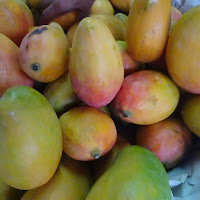Mercado is the Spanish word for market and in Mexico every village, every town, every neighbourhood has at least one. In most cases they are held in a building that is purpose built for this. Here's the beautiful mercado in Tlalpan, a town in the southern part of la Ciudad Mexico. We stopped here on our way to Coyacan, which I wrote about the other day.

Inside this building are dozens of stalls which are owned by vendors of fruit, vegetables, meat, fish, spices, housewares of all kinds, shoes, clothing, and many other things that would normally be found in our stores.
We've always liked the mercados and when we were in Mazatlan we often did our shopping there. The vendors usually are very direct with their prices and there doesn't seem to be a lot of bargaining so it's easy for us. (Someone may contradict me about the bargaining, but we find the prices so reasonable that we don't attempt it.)
A few days ago we visited with our friends Tere and Jose, who live here in the city and run a small school. When Harry was here a year ago he did some volunteer teaching in their school and we've spent a couple of days with them this time around. It's wonderful to go to the mercado with people who are really familiar with the foods and who speak fluent Spanish.
They took us to the market in their neighbourhood and bought us some fruit. This is mamay, something new to me. It's quite unusual with its deep orange colour. I must say it's not my favourite, being a cross between dry canteloupe and sweet potato. Pretty though. The three varieties of mangoes were wondereful, however.
Here's another fruit stall in a market. Maybe this woman is phoning her husband to ask which fruit he would like to have today.
In the past when we went to markets we avoided the areas where people are eating, and it turns out that in doing so we were missing one of the best parts of the mercado experience.
We've been cautious about these little eateries but Tere and Jose showed us how to do it right.
Select a stall that has a lot of employees, that tells you that it's a thriving operation. Order food that is cooked such as soup (caldo or sopa), tacos, gorditas etc. Or try the comida corrida--the daily special usually consisting of three courses plus a fruit drink called agua de fruta.
After being tutored by them, Harry and I tried the comida corrida at the market in Tlalpan and it was delicious and an incredible deal. Lentil soup to start, then a plate of either Spanish rice or pasta, followed by mango chicken and vegetables, plus a large drink. Harry had agua naranja (orange water) which was delicious. They always use bottled water for the drinks so there's no need to worry.
Here's Harry looking quite pleased to be here, and this was our very busy waitress who took excellent care of us. The cost of the meal was $120 pesos, about $4.50 each. And it was delicious and more than I could finish.
Today we went with Tere and Jose to a market close to our neighbourhood here in Roma. It's the Medellin Market and our friend Andrea told us about it. Because it's in an upscale neighbourhood it had more variety of foods and stalls than some others. And it was light and bright. There were several different seafood vendors who get their wares by air from both coasts. Also there were a few very nice looking restaurants.
We sat down in this one and ordered fish tacos, seafood soup, and shrimp pasta.

And for desert, Tere ordered fried bananas. Delish.
Other hints on dining in these places include using the cut limes to disinfect the top of your bottle or glass before your drink from it and wiping the cutlery with one of the many paper napkins on each table.
Here are few more shots of the mercados we've visited over the past few days. Lots of dried peppers, tortilla makers and veggies including cactus leaves.
The Medellin market has its own shrine.
The other market we visited recently was the Mercado de Artisanias, also called la Ciudaduela. It's a huge complex right in the centre of Mexico City where vendors sell art and crafts of every kind and level of quality.
From the hand carved alebrijes from Oaxaca...
to handwoven and stitched fabrics, tin work and much more.
We only saw a small portion of this enormous market, enough to know that we'll be going back again before we head home. It's amazing to see all this stuff in one place.

















































